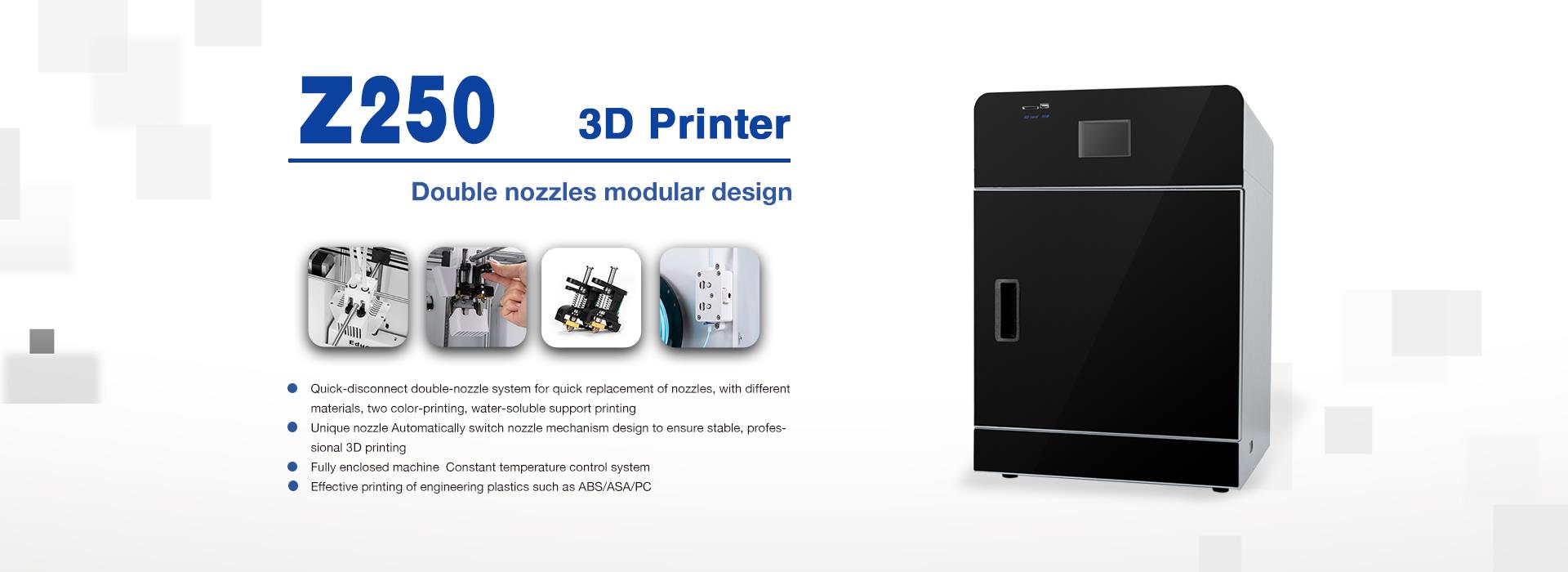Industrial grade 3D printers print carbon fiber, the second most sought after additive manufacturing technology after metal. Thanks to the latest developments in the field of additive manufacturing, people have finally realized the reality of being able to print with a variety of elusive materials. However, not all carbon fiber 3D printers are the same – some machines use micro chopped fibers to reinforce traditional thermoplastics, while others use continuous fibers placed inside a thermoplastic matrix (usually filled with chopped fibers). Create a "skeleton" inside the part.
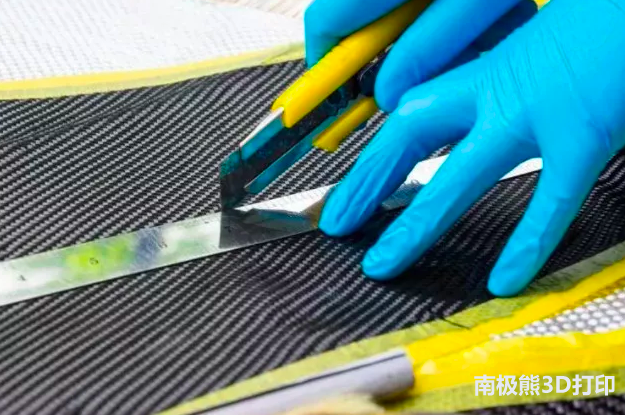
Explain the role of carbon fiber in 3D printing
Carbon fiber consists of aligned chains of carbon atoms with extremely high tensile strength. It is not particularly useful to use them alone - their thin, brittle nature makes them easy to break in any practical application. However, when the fibers are grouped and bonded together using an adhesive, the fibers distribute the load smoothly and form a composite material of extremely high strength and light weight. These carbon fiber composites come in the form of sheets, tubes or custom molded features and are used in aerospace and automotive industries where strength and weight ratio dominate. Usually, a thermosetting resin is used as the binder.
Recent developments in industrial grade 3D printer technology have enabled companies to use carbon fiber for printing, although the bonding materials used are different from standard carbon fiber processes. The resin does not melt and therefore cannot be extruded through the nozzle - to solve this problem, the 3D printer replaces the resin with an easy-to-print thermoplastic. Although these components are not as heat resistant as resin-based carbon fiber composites, they do benefit from the strength of the fibers.
At present, the use of 3D printing additive manufacturing technology in carbon fiber reinforced plastics and composite materials (SCFT, LCFRT, CFRP and CFRTP) has become a fast-growing carbon fiber composite material preparation for digital, intelligent, automated high-tech new technology. Compared with the traditional carbon fiber composite molding and preparation process, it has simple process, low processing cost, high utilization rate of raw materials, green and environmental protection technology, lower manufacturing cost of parts, and structural design and manufacture of composite parts. The integration is completed, no need to open the mold manufacturing, and the digital proofing and printing parts verification can be repeated, which can speed up the development cycle and save development cost, and can be used as an effective technical solution for low-cost rapid forming manufacturing. Carbon fiber reinforced plastics and composites can be used in aerospace and military industries to produce complex, structural components for lighter, stronger industrial grade lightweight composites using industrial grade 3D printer printing technology. The high cost of carbon fiber (CF), complicated preparation process and control, special special equipment for processing and molding, and lack of professional engineers and technicians make it less developed and applied in the 3D printing industry, but at the end of various industries at home and abroad. The application development potential is huge, especially in the research and development of aerospace and new energy electric vehicles with broad application prospects and development.
Printing carbon fiber by FDM melt extrusion requires printing carbon fiber composites together with hot melt plastics. For example, using hot melt plastics such as PETG, PETG itself has good ductility and it can withstand more High CF load while maintaining a certain degree of ductility and impact resistance. It adheres well to a variety of construction platforms and also has excellent layer adhesion, while the addition of carbon fiber increases its rigidity and dimensional stability. The Dutch colorFabb XT-CF20 printing material contains Eastman Chemical's PETG material and 20% carbon fiber material. 3DXTECH is also made of Eastman PETG material combined with high modulus carbon fiber. Another company, Proto-pasta's carbon fiber reinforced PLA, is a synthetic of corn starch-derived derived plastics and carbon fiber composites.
Carbon fiber 3D printing method
There are currently two carbon fiber printing methods: chopped carbon fiber filled thermoplastics and continuous carbon fiber reinforced materials. Short-cut carbon fiber-filled thermoplastics are printed on a standard FFF (FDM) printer consisting of a thermoplastic (PLA, ABS or nylon) reinforced with tiny chopped strands, ie carbon fibers. On the other hand, continuous carbon fiber manufacturing is a unique printing process that places continuous carbon fiber bundles into standard FFF (FDM) thermoplastic substrates.
Short-cut carbon fiber-filled plastics and continuous fibers are manufactured using carbon fiber, but the difference between them is enormous. Understanding how each method works and its ideal application will help you make informed decisions about what to do in additive manufacturing.

3D printed carbon fiber made from chopped carbon fiber filled thermoplastics : Markforged
Chopped carbon fibers are essentially reinforcing materials for standard thermoplastics. It allows companies to print materials that are generally less powerful at higher levels of intensity. The material is then mixed with a thermoplastic and the resulting mixture is extruded into a spool for a melt filament manufacturing ( FFF) technique. For composites using the FFF method, the material is a mixture of chopped fibers (usually carbon fibers) and conventional thermoplastics (such as nylon, ABS or polylactic acid). Although the FFF process remains the same, chopped fibers increase the strength and stiffness of the model and improve dimensional stability, surface finish and precision.
This method is not always flawless. Some chopped fiber reinforced filaments emphasize strength by adjusting the supersaturation of the material with fibers. This can adversely affect the overall quality of the workpiece, reducing surface quality and part accuracy. Prototypes and end-use parts can be made from chopped carbon fiber because it provides the strength and appearance required for internal testing or customer-facing components.
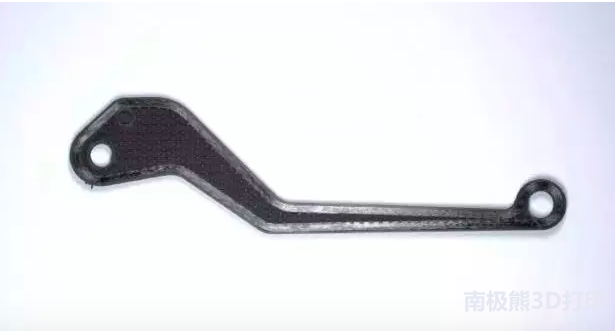
Carbon fiber 3D printing is enhanced with continuous fibers Source: markforged
Continuous carbon fiber is the real advantage. This is a cost-effective solution to replace traditional metal parts with 3D printed composite parts because it achieves similar strength using only a fraction of the weight. It can be used to inlay materials in thermoplastics using continuous filament manufacturing (CFF) technology. A printer using this method lays continuous high strength fibers (e.g., carbon fiber, fiberglass or Kevlar) through a second printing nozzle in a FFF extruded thermoplastic during printing. Reinforcing fibers form the "backbone" of the printed part, producing a hard, strong and durable effect.
Continuous carbon fiber not only increases strength, but also provides users with selective reinforcement in areas where higher durability is required. Due to the FFF nature of the core process , you can choose to build on a layer-by-layer basis. In each layer, there are two enhancement methods: concentric reinforcement and isotropic reinforcement. Concentric fills reinforce the outer boundaries of each layer (internal and external) and extend into the part with a user-defined number of cycles. The isotropic filling forms a unidirectional composite reinforcement on each layer, and the carbon fiber weave can be simulated by changing the direction of reinforcement on the layer. These enhanced strategies enable aerospace, automotive and manufacturing industries to integrate composite materials into their workflows in new ways. Printed parts can be used as tools and fixtures (all of which require continuous carbon fiber to effectively simulate metal properties.), such as tools at the end of the arm, soft palate, and CMM fixtures.
Carbon fiber 3D printing technology
Laser sintering technology
Material characteristics: short fiber reinforced nylon, PEEK, TPU and other powder materials
Process characteristics: Mix short-cut carbon fiber and nylon material in a certain proportion, and realize integral molding by laser sintering.

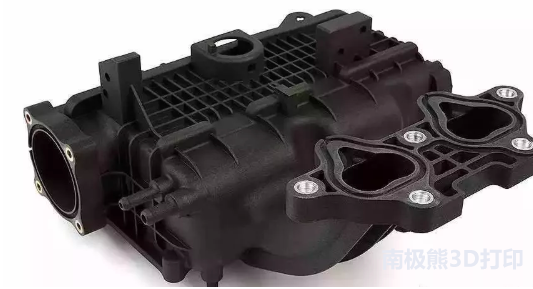
Laser sintered carbon fiber automobile intake manifold function prototype
2. Multi-jet melting technology
Material characteristics: short fiber reinforced nylon, PEEK, TPU and other powder materials
Process characteristics: Through the heating of the lamp tube, the part cross section gathers enough heat to realize melt forming under the action of the solvent.

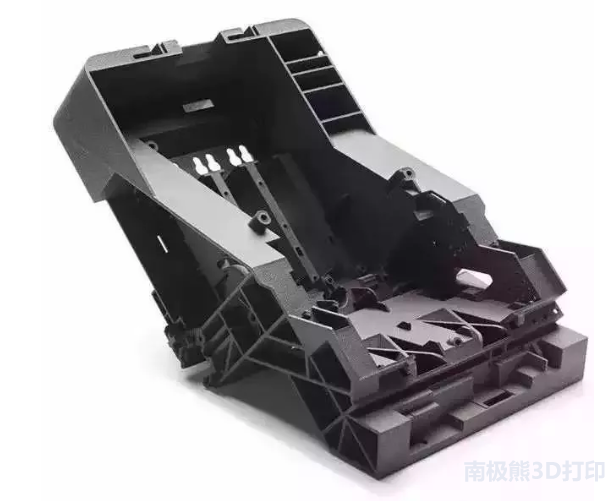
MJF technology printing fiber reinforced parts
3. FDM technology
Material characteristics: long fiber reinforced PLA, nylon, PEEK and other wire materials
Process characteristics: The long fiber is filled into the conventional wire by FDM technology to enhance the effect.


FDM printed carbon fiber reinforced PEEK wing
Carbon fiber 3D printing company
1. Oxford Performance Materials Oxford Performance Materials
OXFAB mainly produces carbon fiber reinforced PEEK materials for 3D printing equipment type SLS. Currently in the aerospace industry, Oxford Performance Materials (OPM) has been selected to provide 3D printed structural components for the Boeing CST-100 rocket spacecraft, and has begun shipping parts for OXFAB material printing. In 2016, composites giant Hexcel also completed a strategic investment in Oxford's performance material OPM.
OXFAB is highly resistant to chemicals and heat, which is critical for high performance aerospace and industrial components. Extensive mechanical testing data demonstrates that OXFAB can be used for complete, ready-to-use parts for 3D printing. OPM is implementing key development contracts with customers in the aerospace and industrial sectors for 3D printed parts for commercial and military aircraft, space and industrial applications, which can significantly reduce weight and cost.
Hexcel has several plants around the world that manufacture a range of advanced materials – including carbon fiber, reinforced fabrics, prepregs (or “prepregs”), honeycombs, mold materials and aircraft structural components. The OPM that acquired Hexcel's investment is more in line with the application side.
2, Stratasys
Stratasys produces carbon fiber reinforced nylon for 3D printing equipment type FDM. Experts in additive manufacturing technology Stratasys' nylon 12CF material for FDM 3D printing technology contains up to 35% carbon fiber, so various properties are excellent, such as a final tensile strength of 76 MPa (MPA). The modulus of elongation is 7529 MPa and the flexural strength is 142 MPa, which is enough to replace metal in many applications, making it ideal for automotive, aerospace and other industries. This carbon fiber reinforced thermoplastic is used to produce high performance prototypes that can withstand the rigorous testing of production parts during design verification to meet the demanding requirements of the production environment and can be applied to fixture manufacturing on the production line.

Stratasys has established a partnership with McLaren. Substantial progress has been made in this partnership, including the installation of some 3D printed parts on McLaren's Formula 1 car.
3. ArevoLabs, Silicon Valley, USA
The company is from the prestigious Silicon Valley of the United States and its main business includes industrial grade carbon fiber 3D printers, new carbon fiber and carbon nanotube (CNT) enhanced high performance materials for 3D printing, and exclusive 3D printing technology and dedicated Software algorithms that use state-of-the-art filament melt 3D printers to produce state-of-the-art super-polymer parts. The company launched its first robotic 3D printing platform (RAM) in late 2015. The platform consists of ABBRobotics' commercial 6-axis robotic system, FDM3D printing components, end effector hardware, and a comprehensive set of software that enables the printing of complex composite parts using high-performance carbon fiber thermoplastic 3D. The RAM is powered by ABB's smallest robot arm, the IRB120, but the expandable software used can be matched and supported by larger models. Depending on the model, the built-in size is a minimum of 1000 cubic millimeters. Up to 8000 cubic millimeters. The end effector hardware includes a thermal management deposition head for processing high performance carbon fiber reinforced thermoplastics. The Arevo software suite converts the computer-aided design model into a set of instructions for performing additive manufacturing to the robot. The software provides six degrees of freedom and a multi-axis tool path with the robotic arm in a variable direction on a three-dimensional surface. A precise kinematics simulation explains the material deposition instructions to verify and optimize the printing process.
4, EnvisionTEC
In 2016, EnvisionTEC launched SLCOM1 industrial grade composite 3D printer for processing carbon fiber fabrics or other varieties of reinforced aramid fabrics. Nylon 6, nylon 11, nylon 12, polyetheretherketone, polyetherketone can be used. Ketones, polycarbonates and many other materials are enhanced. Customized for high quality 3D printed parts such as aerospace, automotive, sporting goods and medical. The tailor-made products fully reflect the extraordinary toughness, weather resistance, shock absorption, high wear resistance and high strength-to-weight ratio of carbon fiber.
5, Electroimpact
The company's flagship device is the Automatic Fiber Placement Device (AFP). It uses ultra-thin carbon fiber prepreg or prepreg automatic placement technology for very fine print quality. The machine has a robot arm up to 6.4m long, and the head has 16 devices similar to those of the old sewing machine. The whole arm is mounted on a 12m long track, which can move around the model quickly and print at the same time. Significantly reduce production time and cost of parts and prototypes. The basic principle of AFP is similar to that of a conventional FDM printer. It can print parts up to 8m long and print speeds of up to 50m/min on uneven and complex surfaces. Some well-known institutions and companies have already purchased AFP equipment and products. For example, NASA's Marshall Aerospace purchased AFP prints as parts for spacecraft, and Boeing also purchased several Electroimpact AFP equipment. Wanted to make composite structures on technical wings
6, ImpossibleObjects
The company's patented Composite 3D Printing Process (CBAM) process shapes specific materials in layers and fuses them together with a built-in heat source. Remove the unwanted material after printing is complete. ImpossibleObjects uses stronger materials for 3D printing technologies such as carbon fiber, Kevlar and fiberglass. After printing, the parts are 2 to 10 times stronger than the parts printed with 3D using traditional thermoplastic materials. Due to its unique composite composition, users can also customize it for a variety of applications, including thermal and chemical corrosion. Robert Swartz, founder of Impossible Objects, believes that the ability to print carbon fiber parts will make 3D printing technology more useful in many areas. The plastic parts currently produced by 3D do not perform well, and to improve performance, better materials are needed. ImpossibleObjects has developed a new process. The new process avoids printing carbon fiber, starting with carbon fiber cloth. Above the carbon fiber cloth, the printer accurately sprays the cleaning liquid according to the digital instructions, and then adds the resin according to the design; the carbon fiber cloth is piled up and heated to melt the resin and combine with the carbon fiber; finally, the carbon fiber that cannot be combined with the resin is removed. Impossible0bjects has made available equipment for sale based on the new process. The current business model is to provide customers with high-strength plastic products printing services, they are commercializing their CBAM technology equipment, the next step will be to sell equipment directly.
7, MarkForged
The company launched the world's first desktop 3D printer, MarkOne, which prints composite materials, two years ago. The machine's molding dimensions are 305mm x 160mm x 160mm, enabling the use of carbon fiber and other composite materials to directly produce "continuous fiber reinforced" plastic parts that are mechanically comparable to metal parts. The machine has two printheads, one that uses nylon material and the other that uses high-strength fiber materials such as carbon fiber and fiberglass, and then combines to create superior parts that can rival or exceed aluminum. Mark Forged's CEO, GregMark, believes that carbon fiber is expensive because of its manufacturing process: complex, time-consuming, and labor-intensive. Mark believes that the new technology developed by the company is as simple as designing the parts in the computer, clicking the button, and the parts come out in a few hours. Due to the wide application and practicality of the equipment, the company achieved a 400% return in 2015.
8, GermanRepRap
The Munich-based GermanRepRap company is known for its high-quality 3D printers and 3D printed cables. As the industry continues to grow, on July 20, 2015, the company announced the launch of a new 3D printed carbon fiber cable Carbon20. According to the company, this is a wire that can be used for 3D printed functional parts. Carbon20 wire contains 20% carbon fiber, which is the origin of its name. It is ideal for 3D printing of industrial parts that require reliable rigidity and hardness.
9. Tokyo University of Science
The Matsuzaka Shinsuke team successfully developed a 3D printer capable of 3D printed carbon fiber composites. The filament carbon fiber is immersed in a thermoplastic resin to print a three-dimensional shape. Tested with test pieces, the tensile strength was increased by 6 times compared with the thermoplastic resin. In the future, the density of carbon fibers will be further increased to produce a higher-strength composite material. The results of the strategic basic technology business of the Ministry of Economy, Trade and Industry, which is composed of the Super Resin Industry (Tokyo City, Tokyo), the University of Japan, the Tokyo Institute of Technology, and the Aerospace Research and Development Agency (JAXA). A 3D print head is produced by mixing carbon fiber and a thermoplastic resin, and then the resin head is supplied with carbon fiber soaked in resin. Prior to printing, the carbon fibers need to be heated first to make the resin more easily diffused between the fibers and the fibers. The extruded resin can be continuously supplied to the carbon fiber for 3D printing. The mixing ratio of fiber to resin can be adjusted according to printing needs.
When the carbon fiber is used in combination with the thermoplastic resin polylactic acid, the occupation ratio of the volume fiber is 6.6%, and the tensile strength is 200 MPa, which is increased by 6 times. The modulus of elasticity reached 20 GMPa, a fourfold increase. At this stage, the team has completed the production of printheads and successfully 3D printing. In the future, they aim to increase the carbon fiber density by about 10 times to further improve the printing accuracy.
Today, the field of additive manufacturing has exploded, and some printers offer the ability to print on carbon fiber. If the 3D printing industry wants to gain more market share in the $100 billion manufacturing market, 3D printing technology needs to be exerted in both process technology and materials. The various advantages of carbon fiber reflect the possibility that this goal becomes a reality. To be sure, to compete with traditional manufacturing, composite materials are bound to be one of the driving forces behind 3D printing becoming mainstream technology.

